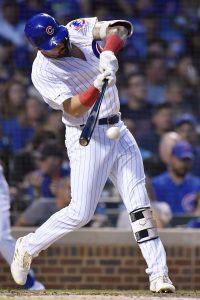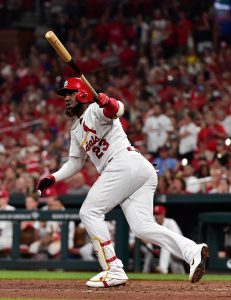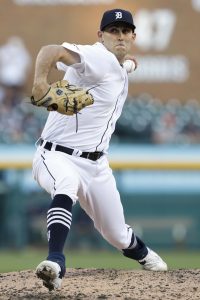We took a look earlier tonight at what the National League’s teams have done to improve their weakest position (as per bWAR) from the past season, and now let’s turn our attention to the 15 American League clubs….
Angels (Catcher, -0.7 bWAR): Amidst signing Anthony Rendon and bringing in pitching, the Halos have also been looking for catching help in trade talks and free agent negotiations, with potential targets Jason Castro and Robinson Chirinos still among the remaining available names. The search for catching has yet to bear fruit, however, leaving Los Angels with Max Stassi and Anthony Bemboom as its current backstop tandem, and hardly an improvement over even the position’s meager 2019 output. First base was another negative (-0.1 bWAR) position last year, though the Angels are hoping Tommy La Stella keeps up his strong hitting while moving to the primary first base role, and anything can be mined from Albert Pujols in the declining slugger’s 20th Major League season.
Astros (First base, 2.4 bWAR): This is an ideal time to point out that the idea of a “weakest position” is all relative, as the Astros win the prize for the best “worst” position in all of baseball. Houston would be perfectly happy with a repeat performance from Yuli Guerriel, and utility options Aledmys Diaz and Abraham Toro are on hand to back up the position.
Athletics (Designated hitter, 0.3 bWAR): After signing Khris Davis to a two-year, $33.5MM extension covering the 2020-21 seasons, the A’s couldn’t have been pleased to see Davis post the worst season of his seven-year career. With just a .220/.293/.387 slash line and 23 homers, the bat-only Davis was a sub-replacement player himself and almost dragged the entire DH spot down with him into negative-bWAR territory. Oakland can only hope that Davis gets back on track in 2020, or else the low-payroll A’s might find themselves in the awkward position of having to bench their highest-paid player if the club is in another pennant race.
Blue Jays (Right field, -0.1 bWAR): Speaking of highly-paid players coming up short, the Blue Jays received nothing from their right field spot despite the regular presence of Randal Grichuk, who signed an extension in April that guaranteed him $47MM in new money over the next four seasons. While Grichuk didn’t hit much in 2019, he also wasn’t solely responsible for the lack of right field production, as the likes of Billy McKinney, Brandon Drury, Socrates Brito, and even Eric Sogard and Cavan Biggio all saw time in right while Grichuk was used in center. It isn’t yet known if Grichuk will remain in right field or again be needed in center, but regardless, Toronto will need Grichuk or another right field option like Derek Fisher to be much more productive.
Indians (Designated hitter, 0.7 bWAR): While the Tribe will technically be keeping the DH spot open for multiple players, it’s probably safe to assume that Franmil Reyes will get the bulk of action at the position. Acquired from the Padres as part of the Trevor Bauer blockbuster at last year’s trade deadline, a full season of Reyes’ power potential should give Cleveland the extra thump they were missing at DH last season whenever Carlos Santana was at his customary first base spot.
Mariners (Center field, -0.5 bWAR): It’s been a pretty quiet winter overall for the Mariners, and with the youth movement on, the M’s aren’t likely to bring in veteran help to either support or supplant Mallex Smith as the regular center fielder. The Mariners will hope that Smith can improve on a lackluster 2019 that saw him take big steps backwards both offensively and defensively, with youngsters like Jake Fraley or Braden Bishop on hand to step in should Smith continue to struggle.
Orioles (Relief pitching -0.5 bWAR): As you might guess, the O’s bottomed out at numerous positions, including negative bWAR measures in left field (-0.4) and center field (-0.1). The decision to deal Jonathan Villar to the Marlins in a virtual salary dump indicates that Baltimore won’t be spending much of anything on its MLB roster in 2020, so any relief additions will be low-cost veterans and minor league signings.
Rangers (Catcher, -2.0 bWAR): Good news for the Angels, as they didn’t have nearly the worst catching corps in the AL West! Jose Trevino, Jeff Mathis, Isiah Kiner-Falefa, and Tim Federowicz are all still in the organization, however, with Nick Ciuffo’s minor league deal representing the only new addition. Like the Angels and probably every other catcher-needy team still on the market, the Rangers have had talks with Chirinos and Castro. Either would bring some type of stability to a position that was a major weak link for Texas in 2019, even while the club’s more heavily-publicized needs in the rotation and at third base have drawn more attention thus far in the offseason.
Rays (Catcher, 0.7 bWAR): Speaking of teams that need catching help, the Rays have seemingly spent years on a perpetual hunt for backstops, and now just saw Travis d’Arnaud depart for a two-year contract with Atlanta. This leaves the Rays with Mike Zunino and Michael Perez, and since this combo wasn’t good enough for 2019, Tampa Bay is likely to continue looking throughout the winter. They’re not equipped to sign Chirinos or Castro if it comes down to a bidding war against most well-heeled clubs, so a trade might be the Rays’ better bet.
Red Sox (Second base, -0.2 bWAR): The newly-signed Jose Peraza is probably Brock Holt’s replacement in the utility infield role, and the keystone looks like it’ll be Peraza’s primary source for playing time given how Boston is mostly set around the rest of the diamond. Peraza will have to rebound from a poor 2019 campaign, as will re-signed utility infielder Marco Hernandez. Former top prospect Michael Chavis is a more promising name in the mix, though for now it seems like the Red Sox will mostly deploy him at first base. The x-factor is Dustin Pedroia, who is hoping for a midseason comeback after missing virtually all of the last two years due to knee injuries. It isn’t exactly the most inspiring collection of second base candidates, though the Sox don’t have much to spend as they seem largely focused on getting under the luxury tax line.
Royals (First base, -1.9 bWAR): Ryan O’Hearn’s rough season leaves first base as an open question for Kansas City heading into 2020, though the addition of Maikel Franco at third base has shuffled the infield deck. K.C. could go with a lefty/righty platoon of O’Hearn and Ryan McBroom, or Hunter Dozier or Whit Merrifield could now factor into the first base mix when they’re not in the outfield. There’s room for the Royals to add an inexpensive first base bat if they aren’t fully prepared to go with the kids.
Tigers (Catcher, -2.2 bWAR): Detroit fielded the worst collection of position players in baseball last season, as the 0.2 bWAR generated in center field and in right field represented the team’s best positions. The Tigers addressed second base (-0.9 bWAR) by signing Jonathan Schoop and first base (0.1 bWAR) by inking C.J. Cron, and for their biggest need behind the plate, another veteran free agent was acquired in Austin Romine. The longtime Yankees backup has quietly hit .262/.302/.428 with 18 homers over the last two seasons and 505 plate appearances, and he’ll now get his first real crack at a regular starting job. There’s no real downside in these one-year deals for Romine, Schoop, and Cron, as the Tigers inch their way back towards respectability.
Twins (First base and left field, 2.0 bWAR): Even the weakest links on the Bomba Squad were still pretty powerful, as Cron hit 25 homers as Minnesota’s primary first baseman and Eddie Rosario swatted 32 home runs in left field. Cron, however, was non-tendered and the Twins have floated Rosario’s name in trade talks, so the club clearly feels improvement can be found. Super-utilityman Marwin Gonzalez can handle either position in a pinch and is currently slated for first base, though with the Twins in the hunt for Josh Donaldson, Miguel Sano could find himself shifted from third base across the diamond to first. If Rosario was dealt, Minnesota could continue its big-game hunting by getting into the Marcell Ozuna chase for the left field vacancy, or just rely on Gonzalez until star prospect Alex Kirilloff is potentially ready to make his big league debut later in the season.
White Sox (Right field, -1.8 bWAR): Chicago only had a cumulative 0.0 bWAR for its outfield as a whole (second-worst total in the majors), with right field being the biggest culprit. While Nomar Mazara hasn’t been too far above replacement level himself during his four years in the majors, the White Sox are hoping that the newly-acquired right fielder will be a post-hype breakout now that he has landed in a new environment. A right-handed hitting platoon partner for Mazara could still be pursued, though the Sox are reportedly more focused on bullpen additions than outfielders right now. The Sox also had a negative bWAR (-0.4) from their designated hitters in 2019, though that position has been firmly bolstered with the signing of Edwin Encarnacion.
Yankees (Designated hitter, 1.8 bWAR): Another position that is only a “weakness” in relative terms, given how the Yankees got great contributions from all over the field despite an almost unimaginable string of injuries. With these health concerns in mind, obtaining an actual full-time DH probably won’t happen, as New York will want to cycle multiple players through the designated hitter spot for the sake of partial rest days. Giancarlo Stanton is the likely candidate to receive the majority of DH time in the wake of his injury-filled 2019 season.



